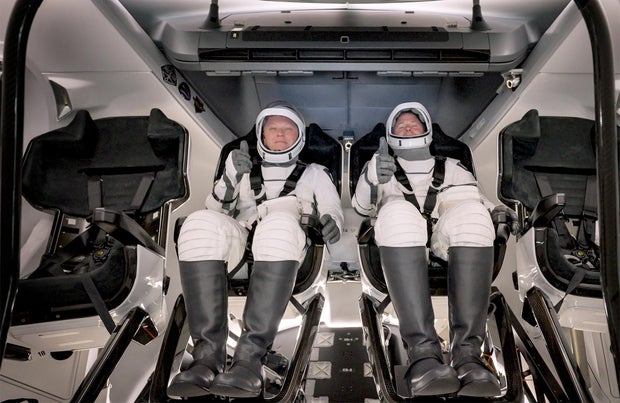NASA’s 10th Crew Dragon flight to the International Space Station is ready for launch Saturday with two long-duration crew members on board along with two empty seats that will be used next February to carry Boeing’s Starliner astronauts back to Earth after an extended stay in orbit.
Crew 9 commander Nick Hague and Russian cosmonaut Alexander Gorbunov are scheduled for liftoff from pad 40 at the Cape Canaveral Space Force Station atop a Falcon 9 rocket at 1:17 p.m. EDT Saturday, roughly the moment Earth’s rotation carries the rocket into alignment with the station’s orbit.
NASA
Already delayed two days by high winds and clouds associated with Hurricane Helene, forecasters predicted a 55 percent chance of acceptable weather along Florida’s Space Coast. There was a “moderate” risk of high winds and waves in the Atlantic Ocean along the spacecraft’s trajectory where the crew might have to land in an abort.
All earlier Crew Dragon flights took off from nearby pad 39A at the Kennedy Space Center. The Crew 9 launch will be the first piloted flight from pad 40 after decades of service launching military satellites, NASA probes and, more recently, unpiloted SpaceX satellite and ISS cargo missions.
NASA required SpaceX to upgrade pad 40 to support piloted flights out of concern that a major launch mishap could knock pad 39A out of action for an extended period, interrupting astronaut ferry flights to the International Space Station.
Pad 40 now features a 265-foot-tall launch support tower, a 91.5-foot-long crew access arm for astronauts and technicians to reach a waiting Crew Dragon and a pad escape system to enable flight crews and support personnel to quickly slide to the ground from 220 feet up in a flexible, fire-resistant tube-like chute in an emergency.
As with all space station flights, Crew 9 will be launched directly into the plane of the lab’s orbit. Twelve minutes after liftoff, the Crew Dragon “Freedom,” making its fourth flight, will be released to fly on its own.
NASA
If all goes well, the spacecraft will execute an automated rendezvous, catching up with the space station from behind and below early Sunday, looping up to a point directly in front of the outpost and then moving in for a docking at the lab’s forward port around 5:30 p.m.
Standing by to welcome Hague and Gorbunov aboard will be their new crewmates, Starliner commander Barry “Butch” Wilmore and his co-pilot Sunita Williams, now serving as commander of the space station.
Also on board: Soyuz MS-26/72S commander Aleksey Ovchinin, Ivan Vagner and NASA astronaut Don Pettit, launched Sept. 11, along with Crew 8 commander Matthew Dominick, Mike Barratt, Jeanette Epps and cosmonaut Alexander Grebenkin, who were launched March 3.
The Crew Dragon originally was expected to carry four passengers: Hague, Gorbunov, veteran Stephanie Wilson and rookie Zena Cardman, the mission commander. But Cardman snd Wilson were removed from the flight in late August to free up two of the Crew Dragon’s four seats for use by Wilmore and Williams.
Clothing, supplies and SpaceX pressure suits also are going up for Wilmore and Williams, who were launched June 5 on the Starliner’s first piloted test flight, a mission initially expected to last eight to 10 days. By the time they land aboard the Crew 9 capsule around Feb. 22, they will have logged more than 262 days in space.
“There have been a lot of changes to our particular crew, but the mission really hasn’t changed,” said Hague. “The mission hasn’t changed for two-and-a-half decades. It’s to get up to the station and do research, and that mission is bigger than any one crew.”
NASA
But that doesn’t mean the transition from four crew members to two, and his own transition from pilot to mission commander, is not without its challenges. Likewise, Wilmore and Williams must learn the ins and outs of flying aboard a Crew Dragon.
“We’re going to launch as a two-person crew, and then we’re going to land as a four-person crew,” Hague said. “And one of the unique challenges of that is, how do we integrate the other two crew members into the Dragon operations when they’ve had very minimal Dragon training before they launched?
“The teams on the ground have helped not only get us ready, but they’ve already started helping Butch and Suni train to understand what they’re going to need to do inside of inside of the Dragon. That’s going to be top priority when we get there, (helping) them understand what they’re going to need to do to operate as part of the Crew 9 crew.”
The four Crew 8 fliers — Dominick, Barratt, Epps and Grebenkin — are expected to head home as early as Oct. 7 to wrap up their own 217-day mission.
That will leave the space station with a normal complement of seven full-time crew members, the three Soyuz fliers — Ovchinin, Vagner and Pettit — along with the revised Crew 9 crew: Hague, Gorbunov, Wilmore and Williams.
Hague said he had trained with both Wilmore and Williams over the years, and he expects the crew the mesh smoothly in orbit.
“I’ve had opportunities to work with Butch and Suni,” Hague said. “I’ve had opportunities to train as part of NOLS (National Outdoor Leadership School) and share a tent with Suni for 10 days in the wilderness. So we know each other, and we’re professionals. We step up and do what’s asked of us.
“So I’m looking forward to working with them, and I think we’re going to pull together without a problem.”
Hague is a Space Force colonel, a former F-16 test pilot and combat veteran who logged 203 days in space on an earlier mission. He also went through a dramatic in-flight abort during launch aboard a Russian Soyuz spacecraft in 2018. His range of experience presumably played a major role in NASA’s decision to move him into the commander’s seat for the revised mission.
SpaceX
Gorbunov kept his seat aboard the Crew 9 Dragon under a high-priority contract between NASA and Roscosmos, the Russian federal space agency, in which three-seat Russian Soyuz spacecraft carry one NASA astronaut on each flight to the ISS and a cosmonaut launches on each four-seat Crew Dragon.
That ensures each country always has at least one crew member on board the lab even if an emergency forces one ferry ship and its crew to make an unplanned return to Earth. Gorbunov is not trained to serve as a Crew Dragon pilot, but he will be sitting in the pilot’s seat during launch to assist Hague.
“Essentially, we’re flying without a pilot, and so fundamentally, the commander is responsible for keeping the crew safe, keeping the vehicle safe and making sure we get the mission done,” Hague said. “And so those responsibilities haven’t changed.
“Alex is going to be working to support me during all the dynamic phases of flight and provide me with the extra set of eyes, the extra set of hands that I would need and that I would leverage if I had a pilot sitting next to me. So in that way, it’s not very different.”
In the wake of the space shuttle’s retirement in 2011, NASA awarded contracts to SpaceX and Boeing to build commercial astronaut ferry ships to carry crews to and from the space station. NASA wanted two providers to maintain crew rotation flights even if one carrier was grounded by technical problems.
The Starliner test flight, the first with a crew on board, was launched on June 5 with a known helium leak in the propulsion pressurization system. During approach to the space station the next day, four more helium leaks were detected, along with degraded thrust in five aft-facing reaction control system jets.
While the docking was successful, the problems kicked off weeks of tests, analyses and debate about the safety of the Starliner during its trip back to Earth. The mission, initially expected to last a little more than a week, was repeatedly extended while testing continued.
SpaceX, in the meantime, had its own problems. On July 11, the upper stage of a Falcon 9 rocket suffered a malfunction that left its payload of Starlink internet satellites in a lower-than-planned orbit. All 20 satellites quickly fell back into the atmosphere and burned up.
SpaceX quickly identified the problem, implemented a fix and flights resumed within about two weeks. But Hague said the problems Boeing and SpaceX encountered demonstrated the value of having multiple providers.
“We’re one launch anomaly from losing our ability to support this amazing thing that we do on the International Space Station,” he said. “We’re trying to develop Starliner to be that redundant system. And just as we’re doing that, we see an anomaly ground the entire Falcon 9 fleet.
“And so in an instant, we’ve lost the ability to support this critical mission, not just for the U.S. but the globe. That underscores why we need redundancy more than anything I can think of.”
When the decision was made to send the Starliner home without its crew, NASA chief astronaut Joe Acaba had to decide who would fly aboard the Crew 9 mission and who would stay behind. While he did not explain his reasoning in a NASA statement announcing the decision, Hague’s spaceflight experience clearly made the difference.
“While we’ve changed crew before for a variety of reasons, downsizing crew for this flight was another tough decision to adjust to given that the crew has trained as a crew of four,” he said in a statement.
“I have the utmost confidence in all our crew. … Zena and Stephanie will continue to assist their crewmates ahead of launch.”
In the same statement, Cardman said “I am confident Nick and Alex will step into their roles with excellence. All four of us remain dedicated to the success of this mission, and Stephanie and I look forward to flying when the time is right.”
For his part, Gorbunov, the fifth Russian to fly aboard a SpaceX ferry ship, told reporters after arriving at the Kennedy Space Center that he could not wait to fly on the Crew Dragon “and to become part of the ISS crew.”
“As we are talking in front of you right now, there are hundreds of people from NASA and SpaceX working on, preparing the launch pad, preparing the rocket for our launch,” he said through an interpreter. “So I would like to express my deepest gratitude to all of them.”





